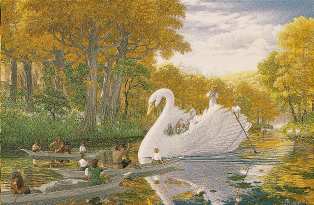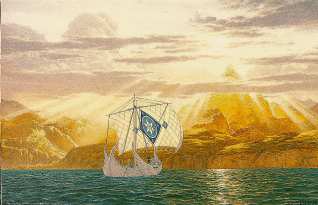|
|
|
Avallónë
I call my home Avallónë, which is Tolkien's variation on Avalon, the island final resting place of King Arthur. And indeed Avalon Bay is right nearby, with Arthur Road just a short distance up the hill in back. The path that goes by my place, popularly known as the Greenway, is a continuation of Avalon Bay Road. The southermost promontory of this magical isle is graced by several small islands, including the Grace Islands, and Druid Island, which becomes attached to the main part of the island at the lowest tides.is a continuation of Avalon Bay Road. In Tolkien's stories Avallónë is on the island of Tol Eressëa, the point of disembarkation for the Undying Lands, which can only be reached by magical ships which sail off to the West from the Grey Havens when the elves finally decide to leave Middle Earth.
Geoffrey of Monmouth names it in Latin as Insula Avallonis in the Historia Regum Britanniae and Insula Pomorum or "island of apples" in the Vita Merlini. It is the home of Morgan le Fay, an enchantress, who is described as the chief of nine sisters living on the island, also recorded by the Roman writer Pomponius Mela who told of nine Celtic priestesses able to turn into animals, heal the incurable, and prophesy the future, who live on the Gaulish island of Sena (Isle de Seine) off the coast of Brittany. Avallon is also a town in Burgandy, originally a Gaulish settlement with the definite meaning of "apple".

The name Avalon probably originally comes from early Celtic avallo, meaning "apple" or possibly from Irish oileán which means "island". All stemming from the Celtic root avallo are Old Irish aball, Middle Welsh afall, and Middle Breton avallenn, In Welsh the island is called Ynys Avallach., a name which also appears in Welsh genealogical and legendary stories as King Avallach, ruler of the island and father of Morgan. It is also noteworthy that, in Irish mythology, the name of the Elysian otherworld isle over the seas belonging to the sea-god Manannan was called Emhain Abhlach, "rich in apple trees".
Avalon is described variously as an island of departed spirits or conversely, since the whole point in so many of the most famous stories of King Arthur is that though wounded and in need of care he will someday return, as a healing place. In 1191 the monks of Glastonbury claimed to exhumed Arthur's remains along with a cross bearing the name Avalonia. Malory has King Arthur carried off to Avalon in a barge. Tennyson says:
... the island-valley of Avilion
Where falls not hail, or rain, or any snow,
Nor ever wind blows loudly; but it lies
Deep-meadow'd, happy, fair with orchard-lawns
And bowery hollows crown'd with summer sea.
Geoffrey of Monmouth states that the island is called Fortunate, located somewhere over the Western Waters, and it has deep associations with the Fortunate Isles of classical Greek and Latin tradition. Indeed Geoffrey speaks of self-sown grain, vines that flourish without tending, and inhabitants who live for a century or more. In the medieval romances of Europe the island became a sort of Earthly Paradise variously located everywhere from the Mediterranean and Far East, to being identified with the original Garden of Eden, which brings us back to the apple...
